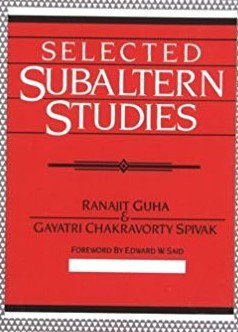Difference between revisions of "A Study of Subaltern Studies"
(Created page with "thumbnail|left|250px|Selected Subaltern Studies Historical articles in the edit collection <i>Selected Subaltern Studies</i> by historians and s...") |
(No difference)
|
Revision as of 16:31, 25 March 2017
Historical articles in the edit collection Selected Subaltern Studies by historians and social theorists Ranajit Guha, Dipesh Chakrabarty, Vinay Bahl, Florencia Mallon and others, examine the origin, development, and potential of Subaltern Studies within the academic community. The selected works discussed below address the social and economic implications of this post-colonial approach to historical interpretation. Introduced in India by historian Ranajit Guha in the early 1980s, Selected Subaltern Studies departs from both colonial and Marxist interpretations of the popular experience of the Indian people under colonial domination, seeking to recognize the agency and purpose embedded in their insurgency and resistance.
In Selected Subaltern Studies, Guha enumerates the dangers and limitations of the historiography of colonial India and suggests a new way to read official and administrative colonial archive records. His treatment of institutionalized colonial dishonesty is dynamic and successful as he offers analytical tools that enable historians to ‘read against the grain’ as they cull colonial archives, and recognize the “code of pacification” (Guha 59) that obscures the power and intent of subaltern insurgency. Using concepts of hegemony and resistance first articulated by Antonio Gramsci, Guha makes a profound contribution to the academic effort to separate the historian’s perspective from that of the state. In his article Subaltern Studies and Postcolonial Historiography, Chakrabarty explains Subaltern Studies’ radical departure from Marxist historiography and offers a reasonable defense of Subaltern Studies in the face of recent criticism.
Chakrabarty lists Subaltern Studies points of departure from previous historical interpretations of power and agency: (a) power is multi-dimensional and separate from capital (b) power bases exist outside of the center-periphery paradigm (c) the nation state is not the best basis for definitions of political activity. With the foundation for Subalternists’ perception of power and agency specified, the reader comprehends the radical paradigm shift represented by this new interpretation. If peasants are not backward and ‘pre-political’, but instead active agent in their own political destiny, experiencing “dominance without hegemony” (Chakrabarty 21) and consciously inverting colonial codes of behavior and destroying colonial symbols of power, then their previously dismissed forms of resistance gain legitimacy. The weakness in this approach stems from the types of archival sources available to scholars looking for evidence that the Subaltern was the “maker of his own destiny” (Chakrabarty 22). Often at a loss for written transcripts of Subaltern experience such as diaries or letters, Subalternists must look at the actions of the Subalterns to access the “collective imagination inherent in the practices of peasant rebellion” (Chakrabarty 23). When historians interpret the actions of a wide swathe of largely illiterate individuals and define their intentions and experiences, they run the risks of producing scholarship rife with assumption, projection, and ultimately, elitism.
Marxist historian Bahl offers criticisms of Subaltern Studies in her article "Situating and Rethinking Subaltern Studies for Writing Working Class History" that point out the archival limitations mentioned above, as well as many other issues. Concerned with the abandonment of the Marxist paradigm, Bahl attacks the academic origins and social implications of Subaltern Studies. For example, Bahl points to the Western influences apparent in Subaltern Studies and questions the legitimacy of an approach that at once rejects Western historiography and relies on Western tools of historical interpretation such as postmodernism in order to replace examination of class consciousness with inquiry into the production of meaning. This argument is not compelling, as it implies academic integrity somehow follows from an ethnocentric censorship of ideas. Concerns with the social implications of Subaltern Studies are more convincing, as the world situation reflects many of the fears articulated by Bahl. The replacement of the ideas of class consciousness and struggle with the focus on identity and ‘difference’ provide the language that enables academics, economists and politicians to ignore the material reality of the poor and its underlying causes, and to abandon the struggle against exploitation and inequality.
Bahl, and Arif Derlik, offer a more nuanced and profound critique of Subaltern Studies in the introduction to the book, History after the Three Worlds. They voice fears that Postmodernism, Multiculturalism and Sublternism will be but tools in the hands of dominant social and economic powers, tools with which they will render indigenous cultures more manageable and profitable. The article, The Promise and Dilemma of Subaltern Studies, by Florencia Mallon, is a provocative addition to this debate, as it credits the advent of Subaltern Studies for providing alternatives to Eurocentric historiography, while acknowledging the contradictions within Subaltern Studies, for example the way it minimizes issues such as gender, and within subalterns themselves, as they are often both the dominators and the dominated.
